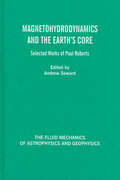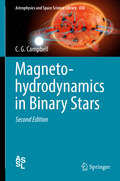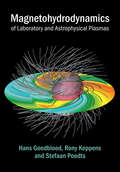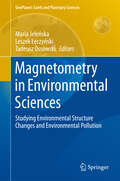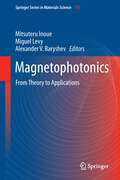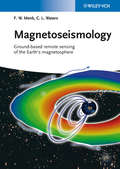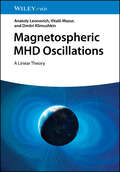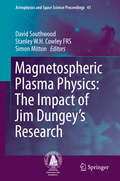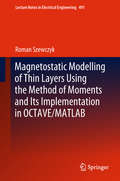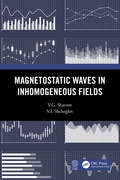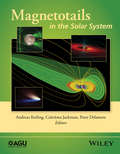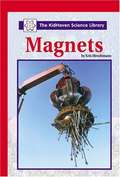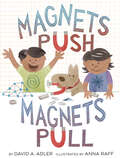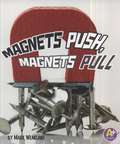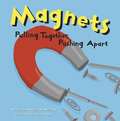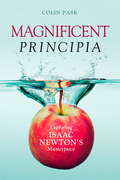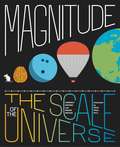- Table View
- List View
Magnetohydrodynamics and the Earth's Core: Selected Works by Paul Roberts (The Fluid Mechanics of Astrophysics and Geophysics)
by Andrew SowardPaul Roberts' research contributions are remarkable in their diversity, depth and international appeal. Papers from the Paul Roberts' Anniversary meeting at the University of Exeter are presented in this volume. Topics include geomagnetism and dynamos, fluid mechanics and MHD, superfluidity, mixed phase regions, mean field electrodynamics and the E
Magnetohydrodynamics in Binary Stars (Astrophysics and Space Science Library #456)
by C. G. CampbellMagnetism in binary stars is an area of central importance in stellar astrophysics. The second edition of "Magnetohydrodynamics in Binary Stars" is a major revision of the first edition. The material has been updated and extended, including additional chapters on the origins of the stellar magnetic fields and accretion disc magnetic winds. A comprehensive account is given of the subject, from the early work up to the latest results. The unifying theme remains the redistribution of angular momentum by magnetic stresses. This occurs in a wide variety of ways, including magnetic stellar and orbital coupling, magnetic channelling of accretion streams, magnetic stellar coupling to accretion discs, dynamo field coupling in discs, and magnetic stellar and disc winds. The associated stellar spin and orbital evolution problems, including stability, are also considered. Although the main focus is on binary stars, much of the work on accretion discs and wind flows has more general astrophysical relevance. Convenient formulae are included that can be compared to observations, making the book useful to observers as well as theorists, and there are extensive reference lists. The material is mainly aimed at research workers, but parts of the text could be useful for postgraduate courses in magnetic stellar astrophysics topics.
Magnetohydrodynamics of Laboratory and Astrophysical Plasmas: With Applications To Laboratory And Astrophysical Plasmas
by Rony Keppens Stefaan Poedts Hans GoedbloedWith ninety per cent of visible matter in the universe existing in the plasma state, an understanding of magnetohydrodynamics is essential for anyone looking to understand solar and astrophysical processes, from stars to accretion discs and galaxies; as well as laboratory applications focused on harnessing controlled fusion energy. This introduction to magnetohydrodynamics brings together the theory of plasma behavior with advanced topics including the applications of plasma physics to thermonuclear fusion and plasma- astrophysics. Topics covered include streaming and toroidal plasmas, nonlinear dynamics, modern computational techniques, incompressible plasma turbulence and extreme transonic and relativistic plasma flows. The numerical techniques needed to apply magnetohydrodynamics are explained, allowing the reader to move from theory to application and exploit the latest algorithmic advances. Bringing together two previous volumes: Principles of Magnetohydrodynamics and Advanced Magnetohydrodynamics, and completely updated with new examples, insights and applications, this volume constitutes a comprehensive reference for students and researchers interested in plasma physics, astrophysics and thermonuclear fusion.
Magnetohydrodynamics of the Sun
by Eric PriestMagnetohydrodynamics of the Sun is a completely new up-to-date rewrite from scratch of the 1982 book Solar Magnetohydrodynamics, taking account of enormous advances in understanding since that date. It describes the subtle and complex interaction between the Sun's plasma atmosphere and its magnetic field, which is responsible for many fascinating dynamic phenomena. Chapters cover the generation of the Sun's magnetic field by dynamo action, magnetoconvection and the nature of photospheric flux tubes such as sunspots, the heating of the outer atmosphere by waves or reconnection, the structure of prominences, the nature of eruptive instability and magnetic reconnection in solar flares and coronal mass ejections, and the acceleration of the solar wind by reconnection or wave-turbulence. It is essential reading for graduate students and researchers in solar physics and related fields of astronomy, plasma physics and fluid dynamics. Problem sets and other resources are available at www. cambridge. org/9780521854719.
Magnetometry in Environmental Sciences: Studying Environmental Structure Changes and Environmental Pollution (GeoPlanet: Earth and Planetary Sciences)
by Maria Jeleńska, Leszek Łęczyński and Tadeusz OssowskiThe book offers a review of the work of the Polish Research Group on selected topics of environmental magnetism: the application of magnetic methods to study pollution of outdoor and indoor air, street dust, polluted soil, air filters and indoor dust; the use of magnetic properties to study pedogenic processes in soils and soil structure; as well as deposition processes in recent sediments. The authors focus on detailed cases and provide in-depth explanations of the causes of and relations between physical processes. The examples of different studies demonstrate how to apply magnetometry to solve problems in related disciplines, how to better understand the complexity of the magnetic structure of substances and mediums as well as how to trace interactions between the environment and natural and anthropogenic factors.
Magnetomicrofluidic Circuits for Single-Bioparticle Transport
by Roozbeh Abedini-NassabThis book highlights the current state of the art in magnetophoretic circuits and their use in the emerging field of single-cell analysis. This interdisciplinary topic involves many fields of science including cellular biology, drug screening, cancer research, personalized medicine, microfabrication, biomedical microdevices, and lab-on-a-chip. This book not only provides the required fundamental knowledge and background needed in magnetics and the circuit theory but also describes the idea of magnetophoretic circuits as well as the cutting-edge developed technologies. It provides a sufficient background in i) the required theory in magnetics, ii) SCAs in general, iii) the circuit theory, iv) the developed idea of the magnetophoretic circuits, v) the fabrication process and magnetic cell labeling techniques, vi) the magnetophoretic-based SCA tools, and vii) the bio-applications. Methods for performing simulations as well as designing, fabricating, and running experiments are explained. Author of the book is one of the inventors of some of the ideas and the author/co-author of some of the related articles in high-impact journals. The book appeals to the readers interested in clinical applications as well as the ones interested in its technical aspects. It is beneficial for researchers interested in the field of single-cell analysis from various disciplines including biomedical engineering, mechanical engineering, electrical engineering, materials science, and cellular biology.
Magnetophotonics
by Alexander V. Baryshev Miguel Levy Mitsuteru InoueThis book merges theoretical and experimental works initiated in 1997 from consideration of periodical artificial dielectric structures comprising magneto-optical materials. Modern advances in magnetophotonics are discussed giving theoretical analyses and demonstrations of the consequences of light interaction with non-reciprocal media of various designs. This first collection of foundational works is devoted to light-to-artificial magnetic matter phenomena and related applications. The subject covers the physical background and the continuing research in the field of magnetophotonics.
Magnetoseismology
by Frederick W. Menk Colin L. WatersThis book provides a comprehensive account of magnetoseismology - the tool to monitor space weather. Written by researcher on the forefront of this field, it conveys the physics behind the phenomena and the methods to detect and investigate them, the relevance to communication, power supply and many other critical systems. In addition, it provides computational codes for analysis and evaluation.
Magnetospheric MHD Oscillations: A Linear Theory
by Anatoly Leonovich Dmitri Klimushkin Vitalii MazurMagnetospheric MHD Oscillations A groundbreaking new theory of the magnetosphere The magnetosphere is the region around Earth in which our planet’s magnetic field exerts its influence to trap charged particles. Waves in this magnetosphere, known as magnetohydrodynamic (MHD) oscillations, are caused by interactions between these charged particles, Solar wind pulses, and the magnetic field. The predictable interval between these oscillations enables them to serve as tools for understanding the magnetospheric plasma which comprises the field. Magnetospheric MHD Oscillations offers a comprehensive overview of the theory underlying these waves and their periodicity. Emphasizing the spatial structure of the oscillations, it advances a theory of MHD oscillation that promises to have significant ramifications in astronomy and beyond. Magnetospheric MHD Oscillations readers will also find: Theorizing of direct relevance to current satellite missions, such as THEMIS and the Van Allen Probe In-depth discussion of topics including Alfven resonance, waveguides in plasma filaments, and many more Detailed appendices including key calculations and statistical parameters Magnetospheric MDH Oscillations is ideal for plasma physicists, theoretical physicists, applied mathematicians, and advanced graduate students in these and related subfields.
Magnetospheric Plasma Physics: The Impact of Jim Dungey's Research
by Simon Mitton David Southwood Stanley W. H. Cowley FRSThis book makes good background reading for much of modern magnetospheric physics. Its origin was a Festspiel for Professor Jim Dungey, former professor in the Physics Department at Imperial College on the occasion of his 90th birthday, 30 January 2013. Remarkably, although he retired 30 years ago, his pioneering and, often, maverick work in the 50's through to the 70's on solar terrestrial physics is probably more widely appreciated today than when he retired. Dungey was a theoretical plasma physicist. The book covers how his reconnection model of the magnetosphere evolved to become the standard model of solar-terrestrial coupling. Dungey's open magnetosphere model now underpins a holistic picture explaining not only the magnetic and plasma structure of the magnetosphere, but also its dynamics which can be monitored in real time. The book also shows how modern day simulation of solar terrestrial coupling can reproduce the real time evolution of the solar terrestrial system in ways undreamt of in 1961 when Dungey's epoch-making paper was published. Further contributions on current Earth magnetosphere research and space plasma physics included in this book show how Dungey's basic ideas have remained explanative 50 years on. But the Festspiel also introduced some advances that possibly Dungey had not foreseen. One of the contributions presented in this book is on the variety of magnetospheres of the solar system which have been seen directly during the space age, discussing the variations in spatial scale and reconnection time scale and comparing them in respect of Earth, Mercury, the giant planets as well as Ganymede.
Magnetostatic Modelling of Thin Layers Using the Method of Moments And Its Implementation in Octave/Matlab (Lecture Notes In Electrical Engineering #491)
by Roman SzewczykThis book presents an efficient and robust method of modelling the magnetostatic properties of different technical elements, especially thin layers for magnetic sensors. The solutions presented utilise the principles of the method of moments. However, the principles have been developed both from the point of view of physical analyses as well as from the point of view of numerical optimisation. To enable cost-efficient use of the solutions for commercial applications in industry, the proposed method was implemented as a code optimised for use in the open-source OCTAVE environment. The scripts can be also used with MATLAB software, which is more user friendly, especially for less experienced users.
Magnetostatic Waves in Inhomogeneous Fields
by V.G. Shavrov V.I. ShcheglovMagnetostatic waves (MSWs) in magnetodielectric media are fundamental for the creation of various highly efficient devices for analog information processing in the microwave range. These devices include various filters, delay lines, phase shifters, frequency converters, nonreciprocal and nonlinear devices, and others. Magnetostatic Waves in Inhomogeneous Fields examines magnetostatic waves and their distribution in non-uniformly magnetized films and structures. The propagation of magnetostatic waves in magnetodielectric environments is accompanied by numerous and very diverse physical effects, sharply distinguishing them from ordinary electromagnetic waves in isotropic media. The authors address dispersion properties and noncollinearity of phase and group velocity vectors, as well as non-reciprocal propagation. Key Features Offers mathematical tools used in the calculation of properties of magnetostatic waves Includes a current literature review of magnetostatic waves and domain structures in garnet–ferrite films Considers the issue of converting magnetostatic waves into electromagnetic ones
Magnetotails in the Solar System
by Andreas Keiling Peter Delamere Caitríona JackmanAll magnetized planets in our solar system (Mercury, Earth, Jupiter, Saturn, Uranus, and Neptune) interact strongly with the solar wind and possess well developed magnetotails. It is not only the strongly magnetized planets that have magnetotails. Mars and Venus have no global intrinsic magnetic field, yet they possess induced magnetotails. Comets have magnetotails that are formed by the draping of the interplanetary magnetic field. In the case of planetary satellites (moons), the magnetotail refers to the wake region behind the satellite in the flow of either the solar wind or the magnetosphere of its parent planet. The largest magnetotail of all in our solar system is the heliotail, the "magnetotail" of the heliosphere. The variety of solar wind conditions, planetary rotation rates, ionospheric conductivity, and physical dimensions provide an outstanding opportunity to extend our understanding of the influence of these factors on magnetotail processes and structures. Collectively, Magnetotails in the Solar System brings together for the first time in one book a collection of tutorials and current developments addressing different types of magnetotails. As a result, this book should appeal to a broad community of space scientists, and it should also be of interest to astronomers who are looking at tail-like structures beyond our solar system.
Magnets
by Kris HirschmannExplains what magnets are, how they changed the world, how they are used in everyday life, and high-tech applications for magnets. Includes bibliographical references and index.
Magnets
by Wiley BlevinsPhonics Readers is a recognized leader in helping you teach phonics and phonemic awareness, within the context of content-area reading. Content area focus: Magnets; Phonics Skills: final e, l-blends
Magnets Push, Magnets Pull
by David A. AdlerExplore the fascinating field of magnetism with this interactive picture book for young learners.Magnetism is all around us--even the earth is a giant magnet. A world without magnets would be a world without cell phones, computers, and more! Trusted children's nonfiction author David A. Adler covers the basics of magnetism, including compasses, for aspiring scientists. Hands-on experiments are smartly woven into the narrative. Want to test out the strength of a magnet? All you need is a bowl of water and some paper clips! Anna Raff's lively art illustrates scientific concepts clearly, with the added fun of two siblings and their dog exploring and learning together. Back matter includes a glossary that defines such terms as attraction, pole, electromagnetism, force, and more. Suggested activities on how to make your own magnet are also included. Finalist for the AAAS/Subaru SB&F Prize for Excellence in Science Books
Magnets Push, Magnets Pull (Science Starts)
by Mark WeaklandCan a magnet really crush a car? How do magnets stick to the fridge without tape or glue? Discover the wonder and science of magnets in Magnets Push, Magnets Pull.
Magnets and Motors: Student Investigations
by National Science Resources CenterNIMAC-sourced textbook
Magnets: Pulling Together, Pushing Apart (Amazing Science)
by Natalie M. RosinskyHave you ever wondered what makes magnets work? Magnets, by Natalie M. Rosinsky introduces many different kinds of magnets, such as motors, compasses, and Earth's magnetic poles. Clear text, vivid illustrations, fun facts, and simple experiments make this book a great introduction to magnets.
Magnificent Principia
by Colin PaskNobel laureate Steven Weinberg has written that "all that has happened since 1687 is a gloss on the Principia." Now you too can appreciate the significance of this stellar work, regarded by many as the greatest scientific contribution of all time. Despite its dazzling reputation, Isaac Newton's Philosophiae Naturalis Principia Mathematica, or simply the Principia, remains a mystery for many people. Few of even the most intellectually curious readers, including professional scientists and mathematicians, have actually looked in the Principia or appreciate its contents. Mathematician Pask seeks to remedy this deficit in this accessible guided tour through Newton's masterpiece. Using the final edition of the Principia, Pask clearly demonstrates how it sets out Newton's (and now our) approach to science; how the framework of classical mechanics is established; how terrestrial phenomena like the tides and projectile motion are explained; and how we can understand the dynamics of the solar system and the paths of comets. He also includes scene-setting chapters about Newton himself and scientific developments in his time, as well as chapters about the reception and influence of the Principia up to the present day.
Magnificent Principia: Exploring Isaac Newton's Masterpiece
by Colin PaskWill help you appreciate and understand the significance of Isaac Newton's masterpiece--what many regard as the greatest scientific contribution of all time.Despite its dazzling reputation, Isaac Newton's Philosophiae Naturalis Principia Mathematica, or simply the Principia, remains a mystery for many people. Few of even the most intellectually curious readers, including professional scientists and mathematicians, have actually looked in the Principia or appreciated its contents.Mathematician Colin Pask seeks to remedy this deficit with this accessible guided tour through Newton's masterpiece. Using the final edition of the Principia, Pask clearly demonstrates how it sets out Newton's (and now our) approach to science, how the framework of classical mechanics is established, how terrestrial phenomena like the tides and projectile motion are explained, and how we can understand the dynamics of the solar system and the paths of comets. He also includes scene-setting chapters about Newton himself and scientific developments in his time, as well as chapters about the reception and influence of the Principia up to the present day.Now in paperback with a new preface, this lucidly written work makes Newton's landmark achievement comprehensible to lay readers.
Magnificent Rebels: The First Romantics and the Invention of the Self
by Andrea Wulf'Elegantly written, deeply researched and totally gripping' SIMON SEBAG MONTEFIOREIn the 1790s an extraordinary group of friends changed the world. Disappointed by the French Revolution's rapid collapse into tyranny, what they wanted was nothing less than a revolution of the mind. The rulers of Europe had ordered their peoples how to think and act for too long. Based in the small German town of Jena, through poetry, drama, philosophy and science, they transformed the way we think about ourselves and the world around us. They were the first Romantics.Their way of understanding the world still frames our lives and being.We're still empowered by their daring leap into the self. We still think with their minds, see with their imagination and feel with their emotions. We also still walk the same tightrope between meaningful self-fulfilment and destructive narcissism, between the rights of the individual and our role as a member of our community and our responsibilities towards future generations who will inhabit this planet. This extraordinary group of friends changed our world. It is impossible to imagine our lives, thoughts and understanding without the foundation of their ground-breaking ideas.
Magnificent Rebels: The First Romantics and the Invention of the Self
by Andrea WulfFrom the Costa Prize-winning author of The Invention of Nature, Magnificent Rebels is a riveting, eye-opening biography of the first Romantics: a revolutionary group of friends based in the small German town of Jena whose modern ideas transformed society and the way we lead our lives today.In the 1790s an extraordinary group of friends changed the world. Disappointed by the French Revolution's rapid collapse into tyranny, what they wanted was nothing less than a revolution of the mind. The rulers of Europe had ordered their peoples how to think and act for too long. Based in the small German town of Jena, through poetry, drama, philosophy and science, they transformed the way we think about ourselves and the world around us. They were the first Romantics.Their way of understanding the world still frames our lives and being. We're still empowered by their daring leap into the self. We still think with their minds, see with their imagination and feel with their emotions. We also still walk the same tightrope between meaningful self-fulfilment and destructive narcissism, between the rights of the individual and our role as a member of our community and our responsibilities towards future generations who will inhabit this planet. This extraordinary group of friends changed our world. It is impossible to imagine our lives, thoughts and understanding without the foundation of their ground-breaking ideas.(P) 2022 Hodder & Stoughton Limited
Magnitude: The Scale of the Universe
by Megan Watzke Kimberly ArcandIn the tradition of illustrated science bestsellers, like Thing Explainer and harkening back to the classic film The Powers of Ten, this unique, fully-illustrated, four-color book explores and visualizes the concept of scale in our universe. In Magnitude, Kimberly Arcand and Megan Watzke take us on an expansive journey to the limits of size, mass, distance, time, temperature in our universe, from the tiniest particle within the structure of an atom to the most massive galaxy in the universe; from the speed at which grass grows (about 2 to 6 inches a month) to the speed of light. Fully-illustrated with four-color drawings and infographics throughout and organized into sections including Size and Amount (Distance, Area, Volume, Mass, Time, Temperature), Motion and Rate (Speed, Acceleration, Density, Rotation), and Phenomena and Processes (Energy, Pressure, Sound, Wind, Computation), Magnitude shows us the scale of our world in a clear, visual way that our relatively medium-sized human brains can easily understand.
